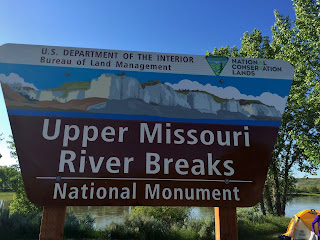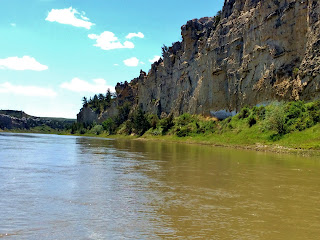UPPER MISSOURI NATIONAL WILD AND SCENIC RIVER
GOING
NATURE’S WAY
By
Kate Crowley
Two thoughts ran
through my mind last week as we began a canoe trip on the Upper Missouri River
in central Montana: “The River is Life”
and “Life is Like a River”. The first
was evident as soon as we arrived at Coal Bank Landing, a campground and launch
site for the river. Tall, thick cottonwood trees hugged the shore and other
trees in the campground were filled with birds.
Late May, of course, is a time when migration is still underway in these
northern regions and that added to the number of species we saw. Three Western Flycatchers chased one another
from tree to tree in a chattering dispute over nesting territory; Yellow
Warblers sang their courtship song from interior branches of the trees; and a
pair of Barn Swallows flew in and out of the porch that fronted the Visitor
Center, occasionally landing near a mud nest under the eaves. These were just three of the most obvious
bird species that entertained us for an afternoon and evening.
This part of Montana is
mostly high plains; famous for growing wheat and normally very dry. This spring has been unusually wet, as the
lush, green hills and a rancher we met confirmed. In the two days of paddling (48 miles) we saw
Bald Eagles (with young in the nest), a Golden Eagle eating its lunch on the
bank of the river, Osprey, White Pelicans, ducks and grebes, and countless
Cliff and Violet Green Swallows. Mammals were less evident, the most common
being the mule deer. At Coal Bank Landing we were able to watch a beaver casually
nibbling on young willow trees (barely saplings) that filled a sandy bar right
next to the boat launch ramp. All of
this life exists because of the muddy water that flows past the banks. This
same water is used by ranchers to irrigate their fields and quench the thirst
of their cattle.
The Upper Missouri
National Wild and Scenic River is managed by the BLM (Bureau of Land
Management) and as such has multiple uses, both recreational and commercial
(ranching). But the important thing to
remember is that this is part of your American heritage and inheritance. You have access to this river because we had
leaders in Congress who saw fit to create the National Wild
and Scenic Rivers System in 1968. The Act was meant “to preserve certain rivers
with outstanding natural, cultural, and recreational values in a free-flowing
condition for the enjoyment of present and future generations”
When President Johnson
signed the Act in October of that year he said, “…our own children and
grandchildren will come to know and come to love the great forests and the wild
rivers that we have protected and left to them. An unspoiled river is a very rare thing in
this Nation today. Their flow and vitality have been harnessed by dams and too
often they have been turned into open sewers by communities and by industries.
It makes us all very fearful that all rivers will go this way unless somebody
acts now to try to balance our river development.” In 2001 President Clinton
through the Antiquities Act created the Upper Missouri River Breaks National
Monument which is land along the River. Permits are not required to boat on
this river (motorboats are allowed) and just recently fees were added for
camping, but like the fees we pay to visit our National and State Parks, they
are nominal and necessary since government financial support continues to
dwindle, while maintenance of these highly popular places continues to
rise.
The second thought
‘Life is like a river’ played in my mind as I thought about the human history
associated with this part of the Missouri River. Just over 200 years ago, Lewis and Clark were
struggling (with their crew) to come up this river in their epic exploration of
the west, American Indians (Blackfeet and Assiniboine) had lived on this land
and used the river for centuries before the explorers and for a brief period in
time (mid-1800s) some intrepid river boat pilots navigated these waters with
steamboats. Physical landforms along the shore still carry names leftover from
that era. Time has changed the use of the river and the people who use it, but
it has not changed.
On a more personal
level, we were there as a family of five, ranging in age from five to seventy.
Our son Jon, his wife Kristin and our granddaughter Teagan shared this
wilderness adventure with us. To use a
common metaphor, our lives flow like a river, whereby we have some control over
the speed and direction our canoes take, but are also controlled to a certain
extent by the time period we are born into.
We can decide where to stop, how long to stay, and how much we enjoy the
experience.
Then there is the quote
by (supposedly) Heraclitus “No man ever steps in the same river twice, for it's
not the same river and he's not the same man.” We change over time and what we
were able to do 30 years ago we can no longer do as our bodies age, but if we
are wise, we learn to adapt and still enjoy those activities in new ways. I
watched Teagan, so new to this world, but already on her way to becoming an
outdoorswoman. I know she will see so many changes in the world that I will
not, but I know she is learning how to adjust to change, challenges and to
enjoy the simplest things in life. We
can’t know when our journey on this river of life will end, but we do have the
ability to decide whether we will absorb and enjoy all the beauty and diversity
it offers.














Comments
Post a Comment